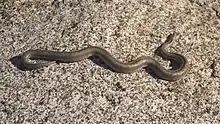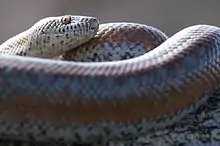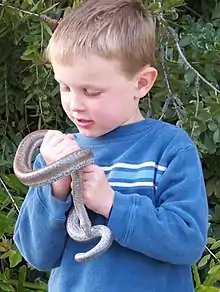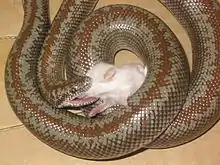Rosy boa
The rosy boa (Charina trivirgata or Lichanura trivirgata) is a species of snake in the family Boidae. The rosy boa is native to the American Southwest and Baja California and Sonora in Mexico. The rosy boa is one of only two species in the boa family native to the United States, the other being the rubber boa (Charina bottae).
| Rosy boa | |
|---|---|
 | |
| Scientific classification | |
| Kingdom: | Animalia |
| Phylum: | Chordata |
| Class: | Reptilia |
| Order: | Squamata |
| Suborder: | Serpentes |
| Family: | Boidae |
| Genus: | Charina |
| Species: | C. trivirgata |
| Binomial name | |
| Charina trivirgata (Cope, 1861) | |
| Synonyms[2][3] | |
Taxonomy
Edward Drinker Cope described the species in 1861. The specific epithet trivirgata refers to the distinct three stripes characteristic of the species. The rosy boa is considered to be the only species within the genus Lichanura, but some researchers have placed it in the genus Charina with the rubber boa (see synonymy). Newer phylogenetic research supports the original arrangement, but herpetologists are still not unified on rosy boa taxonomy. The subspecific designations are just as uncertain, with many sources not accepting L. t. arizonae or L. t. saslowi, and others not recognizing any subspecies as being valid..
Subspecies
- Arizona rosy boa, L. t. arizonae Spiteri, 1991
- Desert rosy boa, L. t. gracia Klauber, 1931 – ground color laced with well-defined pink, orange, or tan longitudinal stripes
- Coastal rosy boa, L. t. roseofusca Cope, 1868 – ground color laced with blotchy reddish-brown longitudinal stripes
- Baja rosy boa, L. t. saslowi Spiteri, 1987
- Mexican rosy boa, L. t. trivirgata Cope, 1861 – ground color laced with pale, creamy broad longitudinal stripes
Description
A small snake, the rosy boa normally attains a total length (including tail) of 17–34 in (43–86 cm), although some coastal specimens from California reach 36–44 in (91–112 cm). A large adult has a body width about the diameter of a golf ball. Coloration of the rosy boa is highly variable, and usually locale-specific. The common name is derived from the rosy or salmon coloration that is common on the belly of specimens of the rosy boa originating from coastal southern California and Baja Mexico. Most rosy boa specimens do not have this ventral coloration, but instead have a series of dark to orange spots on a light-colored background.
Almost all specimens of the rosy boa have at least some trace of three longitudinal stripes, one down the center of the back, and two on the lower sides. The appearance of these stripes varies widely, from extremely straight and having high contrast with the interspaces, to extremely broken with almost no contrast with the interspaces. Stripe colors can be orange, maroon, rust, brown, or black. Interspace colors can be shades of light to dark gray, yellow, or tan.
Distribution and habitat
The rosy boa is found in the Aridoamerica ecoregion, in the southwestern United States in the states of California and Arizona, and northwestern Mexico in the states of Baja California and Sonora. In California, the rosy boa ranges throughout the Colorado and Mojave Deserts and also occupies the coastal areas of Los Angeles, Orange, Riverside, and San Diego Counties. In Arizona, the rosy boa occupies the Mojave Desert and the western areas of the Sonoran Desert. It is absent from the eastern and northern halves of the state. In Sonora, the rosy boa ranges from the border with the United States south throughout the Sonoran Desert to at least as far south as Ortiz. In Baja California, the rosy boa is almost ubiquitous ranging throughout the entire peninsula except in areas of extremely dry or rockless desert.
Behavior
The rosy boa spends most of its life concealed beneath rocks and in crevices to escape the elements and natural predators. Granite outcroppings are the most common geologic association inhabited by the rosy boa. Less often, it is found in association with volcanic or other rock types. Only in rare places does the rosy boa inhabit rockless environments. In areas with few rocks, the rosy boa uses rodent burrows for concealment.

The rosy boa's activity season follows local weather patterns; however, it is generally dormant during the winter, and active during the spring, summer, and fall. Like all snakes, it is dependent on external temperatures to promote such normal bodily functions as digestion and gestation. Throughout most of its range, the winter is too cold for these functions and the rosy boa goes into a dormant state called brumation. The spring is breeding season, resulting in its highest rate of activity. Most specimens of the rosy boa are encountered in spring as they leave the security of their rock piles and crevices to seek mates. Another reason why the rosy boa may be active on the surface of the ground is to find prey or new territory.

The surface activity of the rosy boa can take place during any hour of the day, but during hot weather, it is primarily nocturnal. In the spring, it is often out in the afternoon and early evening. In the late spring and summer, this activity period switches from dusk to late into the night. Because most populations of the rosy boa live in exceedingly dry habitats, activity is often highly moisture-dependent. During dry periods it remains deep underground to assist in remaining hydrated. Recent rainfall often results in a flurry of surface activity.
The rosy boa forages mainly for small mammals, but has occasionally been known to take other prey items, such as lizards, birds, and mammals. Pack rats, baby rabbits, deer mice, and kangaroo rats make up a large portion of its diet. The rosy boa is one of the slowest-moving species of snakes in the world. It is unable to pursue prey and must either wait in ambush or stalk its meals. When a meal is within reach, usually a few inches, a rosy boa strikes with surprising speed and accuracy. Prey is secured with tiny rows of needle-sharp teeth, then suffocated through constriction.
The rosy boa is extremely docile when encountered by humans. When disturbed, it usually rolls into a compact ball with the head in the center.[4] The species is not prone to bite in defense, but rather will release a foul-smelling musk from the base of the tail when threatened. When human bites have occurred, they have usually been the result of a feeding response with a captive animal. The rosy boa is nonvenomous. Its extreme docility, few needs, and attractive coloration have made the rosy boa popular with herpetoculturists.
Reproduction
The rosy boa bears live young, about six in a brood, with newborns about 30 cm (12 in.) in length.[4]

In captivity
Its generally docile temperament and small size make the rosy boa an ideal choice for a pet snake due to it easy care and small enclosure size. It is frequently captive bred, and readily feeds on commercially available mice. Many color variations are available, including albino, as well as the different subspecies. With other species, such as corn snakes, milk snakes, and ball pythons, dominating the majority of the market, the popularity of the rosy boa has not been as high as other species.
References
- Hammerson GA, Frost DR, Gadsden H (2007). "Lichanura trivirgata ". IUCN Red List of Threatened Species. 2007: e.T63726A12711011. doi:10.2305/IUCN.UK.2007.RLTS.T63726A12711011.en.
- Stejneger L, Barbour T (1917). "Lichanura ". A Check List of North American Amphibians and Reptiles. Cambridge, Massachusetts: Harvard University Press. p. 73.CS1 maint: uses authors parameter (link)
- "Lichanura trivirgata ". The Reptile Database. www.reptile-database.org.
- Schmidt KP, Davis DD (1941). Field Book of Snakes of the United States and Canada. New York: G.P. Putnam's Sons. 365 pp. (Lichanura roseofusca, pp. 96–98 & Plate 8).
Further reading
- Behler JL, King FW (1979). The Audubon Society Field Guide to North American Reptiles and Amphibians. New York: Alfred A. Knopf. 743 pp. ISBN 9780394508245. (Lichanura trivirgata, pp. 587–588 + Plates 508, 525).
- Boulenger GA (1893). Catalogue of the Snakes in the British Museum (Natural History). Volume I., Containing the Families ... Boidæ ... London: Trustees of the British Museum (Natural History). (Taylor and Francis, printers). xiii + 448 pp. + Plates I-XXVIII. (Lichanura trivirgata, p. 129).
- Cope ED (1861). "Contributions to the Ophiology of Lower California, Mexico and Central America". Proc. Acad. Nat. Sci. Philadelphia 13: 292-306. (Lichanura trivirgata, new species, p. 304).
- Goin CJ, Goin OB, Zug GR (1978). Introduction to Herpetology, Third Edition. San Francisco: W.H. Freeman. xi + 378 pp. ISBN 0-7167-0020-4. (Lichanura roseofusca, pp. 50, 318-319).
- Smith HM, Brodie ED Jr (1982). Reptiles of North America: A Guide to Field Identification. New York: Golden Press. 240 pp. ISBN 0-307-13666-3. (Lichanura trivirgata, pp. 138–139).
- Stebbins RC (2003). A Field Guide to Western Reptiles and Amphibians, Third Edition. The Peterson Field Guide Series ®. Boston and New York: Houghton Mifflin. xiii + 533 pp. ISBN 978-0-395-98272-3. (Charina trivirgata, pp. 343–344 + Plate 42 + Map 131).
- Wright AH, Wright AA (1957). Handbook of Snakes of the United States and Canada. Ithaca and London: Comstock Publishing Assosciates. 1,035 pp. (2 volumes). (Lichanura roseofusca, pp. 60–66, figures 17-18, map 9).
- Zim HS, Smith HM (1956). Reptiles and Amphibians: A Guide to Familiar American Species. Golden Nature Guides. New York: Simon and Schuster. 160 pp. (Lichanura roseofusca, pp. 73, 156).
External links
- "Charina trivirgata ". Integrated Taxonomic Information System. Retrieved 25 May 2006.
- Species Lichanura trivirgata at The Reptile Database
